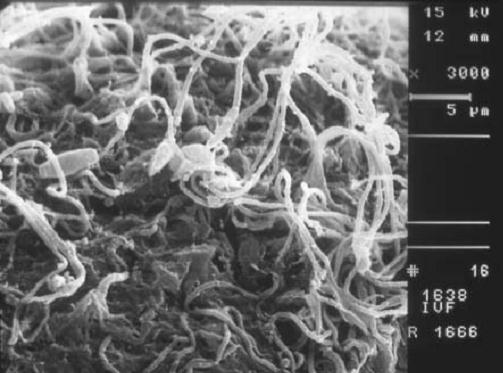


 النبات
النبات
 الحيوان
الحيوان
 الأحياء المجهرية
الأحياء المجهرية
 علم الأمراض
علم الأمراض
 التقانة الإحيائية
التقانة الإحيائية
 التقنية الحيوية المكروبية
التقنية الحيوية المكروبية
 التقنية الحياتية النانوية
التقنية الحياتية النانوية
 علم الأجنة
علم الأجنة
 الأحياء الجزيئي
الأحياء الجزيئي
 علم وظائف الأعضاء
علم وظائف الأعضاء
 الغدد
الغدد
 المضادات الحيوية
المضادات الحيوية|
Read More
Date: 19-5-2016
Date: 28-4-2016
Date: 30-4-2021
|
Fertilization
In the animal kingdom, fertilization is a unique event in which a male and female haploid gamete join and follow a cascade of highly regulated events that results in the production of a new individual )Fig. 1). During the early stages of fertilization, the two morphologically disparate gametes, the oocyte and the sperm, follow a very specific process of recognition and fusion. The interactions between the two gametes and with their tubal environment are mediated by highly specialized molecules located on the outer surfaces of membranes of the gametes and on the surrounding epithelia. The molecular interactions between the oocyte and spermatozoon are also unique with regard to gene function. Both gametes are haploid, and furthermore the nucleus is greatly condensed in the spermatozoa. Thus, no gene transcription takes place; consequently, all biochemical and molecular biological interactions must be done by proteins and, to some extent, by pretranscribed RNA of the oocyte. This means that regulation of the nucleus does not take place; instead, proteins and RNA involved in the fertilization process act autonomously. On the spermatozoon, the adhesion molecules are divided into primary and secondary ligands. Primary ligands are involved in initial gamete binding, whereas secondary ligands, such as proacrosin, come into action after the acrosome reaction has taken place. In the oocyte, interactions with the other gamete are mediated by an extracellular matrix, the zona pellucida (see Egg). This organelle consists of three glycoproteins, ZP1, ZP2, and ZP3, of which ZP1 is responsible for structural integrity, whereas ZP2 and ZP3 have been shown to have sperm receptor activity (1). In the mouse, primary ligands interact with ZP3, whereas secondary ligands like proacrosin also bind strongly to ZP2. Only after completion of all complementary signals and responses is penetration of the spermatozoon through the zona pellucida possible, which directs the transfer of the male genetic information to the oocyte. The fertilization process has been divided into individual steps by Wassarman (1), in a widely accepted scenario:
1. Capacitation. In the female genital tract, ejaculated spermatozoa undergo a process called capacitation. This maturing process of spermatozoa is necessary to gain full fertilization capacity, but the basic mechanisms are not fully understood. Lectins from the seminal cytoplasm adhering to the surface of the acrosomal cap undergo a change in conformation and adopt structures that enable coupling of primary receptors.
2. Attachment. In vitro fertilization experiments demonstrated that the oocyte and spermatozoa initially are attached only loosely. This loose attachment is not species-specific, and the spermatozoa can be removed easily from the egg by small turbulences.
3. Primary binding. After the initial contact, the sperm bind tightly to the zona pellucida. This species-specific interaction is mediated by primary receptors and ligands. Now the spermatozoa cannot be removed easily from the egg by physical means.
4. Acrosome reaction. Triggered by the contact with the zona pellucida, spermatozoa undergo exocytosis, known as the acrosome reaction. This involves hyperactivation of the motile spermatozoa, multiple point fusion of sperm cytoplasm and the outer acrosomal membrane, formation of hybrid vesicles, and exposure of the inner acrosomal membrane. Enzymes (mainly proacrosin) and inner acrosomal components that are necessary for binding, local lysis, and penetration of the zona pellucida are released and come into action.
5. Secondary binding. After the acrosome reaction, secondary ligands and receptors maintain the affinity between the two gametes. The forces are strong enough to keep the spermatozoa tightly attached to the zona pellucida. Adhesive proteins like proacrosin play an important role in high affinity binding.
6. Penetration. After exposure of the inner acrosomal membrane, the predominant molecule of the acrosome, acrosin, has been generated from the precursor proacrosin. It acts as a binding molecule and also a proteinase; these two phenomena together enable the sperm to bind and lyse the zona pellucida locally. The spermatozoon is driven through the zona pellucida, forced by the motile sperm tail.
7. Fusion. The spermatozoon that first reaches the perivitelline space then fuses with the egg plasma membrane to form a zygote. On entry of the spermatozoon, the egg is activated, which leads finally to the unification of the male and female pronuclei.
8. Primary block to polyspermy. In order to prevent several spermatozoa fusing with the oocyte, a rapid depolarization of the egg plasma membrane occurs within seconds after gamete fusion.
9. Cortical reaction and zona hardening. The cortical granules of the egg, which can be regarded as lysosome-like organelles, release a variety of lytic enzymes on the fusion of a spermatozoon with the egg plasma membrane. The cortical granule contents are then deposited into the perivitelline space; when they enter the zona pellucida, the ZP2 and ZP3 glycoproteins are converted into ZP2f and ZP3f, the respective inactive forms of the receptor. This modification of the zona pellucida glycoproteins constitutes a permanent secondary block to polyspermy.

Figure 1. Sperm–egg interaction. Capacitated spermatozoa bind to the zona pellucida via primary ligands and receptors. This event triggers the acrosome reaction of the spermatozoa and activates secondary ligands on the sperm. (With the friendly permission of Dr. H.-W. Michelmann.)
References
1. P. M. Wassarman (1990) J. Reprod. Fert. Suppl. 42, 79–87.



|
|
|
|
مخاطر خفية لمكون شائع في مشروبات الطاقة والمكملات الغذائية
|
|
|
|
|
|
|
"آبل" تشغّل نظامها الجديد للذكاء الاصطناعي على أجهزتها
|
|
|
|
|
|
|
تستخدم لأول مرة... مستشفى الإمام زين العابدين (ع) التابع للعتبة الحسينية يعتمد تقنيات حديثة في تثبيت الكسور المعقدة
|
|
|